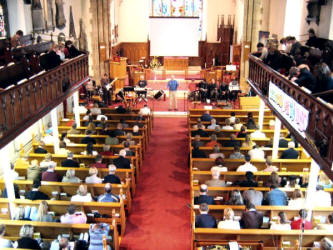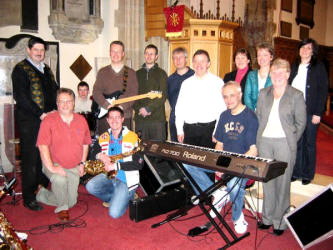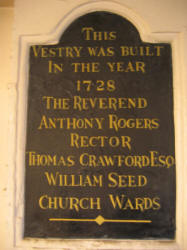
Lisburn Cathedral
|
|
 |
| Lisburn Cathedral. The original church called 'St. Thomas', was consecrated in 1623. The slim octagonal spire of the Cathedral is the tallest landmark in Lisburn. | Interior of Lisburn Cathedral. The Rev. Canon Sam Wright pictured during morning service in this beautiful Lisburn City Centre Church. |
|
|
 |
| Rev. Canon Sam Wrightbr Rector | Simon Genoe
Curate Assistant |
|
|
 |
|
Keith
Neill Youth and Outreach Worker |
Andrew Skelly Organist |
Lisburn Parish consists of the following three churches:
Lisburn Cathedral
Lisburn Cathedral, Christ Church and St. Paul’s.
Lisburn City Centre.
Youth and Outreach: Keith Neill
Church Office Telephone: 9260 2400
Church Web Site: www.lisburncathedral.org
Services:
Morning worship: 9.30am and 11.00am
Evenin worship: 6.00pm
During July and August the congregation joins with some
neighbouring churches
for Summer Epilogue
Services at 8.00pm.
 |
 |
| Some of the musicians and vocalists that lead the praise at Lisburn Cathedral. Pictured L to R are: Michael Heaney, Michael Wright - Percussion, Jonathan Irvine - Guitar, Philip McConnell, Tim Webb, Des Henry, David Brattle - Keyboards, Francis Jess, Rosemary Irvine, Jean Craig and Jo-Anne Irwin. (kneeling at front) Frank Bailie - Music Co-ordinator and Jason Parker - Saxophone. | The stone tablet erected in the vestry of Lisburn Cathedral. |
HISTORY
It is significant and suggestive that in 1608 when Sir Fulke Conway was granted the territory which included that upon which modern Lisburn stands, he built first a place to live and then a place to worship. The castle was completed in 1622, and the church was consecrated in 1623. The church was built on the site where the Cathedral now stands and was called ‘St. Thomas’. It was really a private chapel to the castle, and not at first a parish church.
This church was destroyed by the rebels in 1641. That was the year of the Irish Rebellion, which had as its aims the overthrow of English rule in Ireland, the recovery of the estates forfeited after the flight of the Earls in 1607 the extirpation of Protestantism and the establishment of Romanism. The town of Lisnagarvey, as it was then called, was attacked by a rebel army in November, 1641, and although the garrison was outnumbered and ill-equipped, so resolute was the defence that a notable victory was gained. The rebels, however, set fire to the town, and the whole town, including the castle and church, was burnt and left in ruins.
The church was speedily restored after the Rebellion. A gallery was added in 1674, and in 1697 it was decided by the Vestry “to raise £60 for the repair of the church and churchyard of Lisburn and also for enlarging the said church.” Alas for the sacrifices and schemes of the rector, the Rev. Joseph Wilkins, and his people for the town and church were again destroyed by fire in 1707. The fire began accidentally while the people were at worship, and spread with such rapidity that in a few hours the whole town, with the exception of a few buildings, was destroyed.
Among the buildings destroyed was the First Presbyterian Meeting House. It had been situated in the Longstone area, but after the fire a new site was acquired at Market Square, where a new Meeting House was erected and opened for worship about 1710.
Again the Cathedral was rebuilt. The foundation stone being laid the year after the fire. The spire was added in 1804 and the Chancel was built and consecrated in 1889.
In the year 1662, shortly after the Restoration, Charles 11 established the church ��to be forever hereafter the Cathedral Church and Episcopal Seat of the aforesaid several bishopricks of Down and Connor.” Some years ago questions were raised as to the validity of the Charter granted by Charles II, and in order to remove all doubts as to the status of the Cathedral the Lord Bishop of Connor (the Rt. Rev. Charles King Irwin D.D.) introduced a Bill at the General Synod of the Church of Ireland in 1952. This measure recognised Lisburn Cathedral as the Cathedral of the Diocese of Connor, known as the Cathedral of Christ Church, Lisburn. The Cathedral is notable for its association with Bishop Jeremy Taylor, who held a lectureship in the Cathedral for a time, and was made Bishop of Down and Connor at the Restoration. he was noted for his scholarship and his writings, his two most popular works being “Holy Living” and “Holy Dying.”
When he became Bishop he set himself to restore the life and discipline of the Church of England in his diocese. He took strong action against Presbyterian ministers and in his first Visitation in 1661 he ejected 36 of them from their churches and residences. He died in Lisburn in 1667, aged 54, in a house in Castle Street, and there is a mural tablet in Lisburn Cathedral to perpetuate his memory.
The Cathedral is also notable for its association with the French Huguenots. The Huguenots had a place of worship, known as the “French Church,” situated in Castle Street, on the site now occupied by the Town Hall. Notable Huguenot names associated with the town and Cathedral are Louis Crommelin ‘the father of the Ulster linen trade,’ whose grave is in the cemetery adjoining the Cathedral; and the Rev. Saumarez Du Bordieu, the last Huguenot chaplain to the Huguenot congregation; master of the Classical School in Lisburn for 56 years; curate of Lambeg and vicar of Glenavy. When he died in 1812 his pupils erected both his grave-stone, and an impressive marble tablet and bust which adorns one of the walls of the Cathedral.
In 2003, the 1796 front gates were replaced and in 2004 the clock chimes were heard again. During 2006 the Vestry rooms were extensively refurbished, also flood lighting was been added.
The Rev Canon Sam Wright was instituted as Rector in February 1999. Simon Genoe will be appointed Curate Assistant in Summer 2009. The five Lay Readers at Lisburn Cathedral are: Denis Fullerton, Tony Hall, Karen Webb, Paula Wright and John Quigley.
For a more detailed history of Lisburn Cathedral much of which is taken from the late W. P. Carmody's work, click on: Christ Church Cathedral Lisburn. A brief history
The above article is taken from a 1964 Ulster Star Supplement compiled by the Rev. J. McCaughan. To see the article in full, click on: Ulster Star borough Supplement then go to Section 2 of the supplement entitled “Flourishes in obedience to God’s Word, The Spiritual Borough.”
Also, a full history of the church by the Very Rev. W. P. Carmody. M. A. (1925) is shown on this web site: Click on: Lisburn Cathedral and its past rectors with an appendix.
Brief history as recorded in a book ‘Lisburn’s Rich Church Heritage’ by John Kelly
The original church was called St Thomas. Consecrated in 1623, it was really a private chapel to the castle, and not at first a parish church. When a rebel army attacked the town of Lisnagarvey in 1641, the church was burnt and left in ruins. It was restored after the Rebellion and a gallery added in 1674. It was again destroyed by fire in 1707. Again the church was rebuilt. The foundation stone was laid in 1708 and a spire added in 1804. The chancel was built and consecrated in 1889. In 1662, Charles II established the church to be the Cathedral Church and Episcopal Seat of the bishoprics of Down and Connor. In 2003, the 1796 front gates were replaced and in 2004 the clock chimes were heard again. During 2006 the vestry rooms were extensively refurbished, also flood lighting was added. The present rector, the Rev Canon Sam Wright, was instituted in February 1999. The Rev Kenneth McGrath, who was instituted as Vicar in January 2006, left in January 2009 when he was appointed rector of Kilkeel Parish. Simon Genoe will become Curate assistant in summer 2009. The five lay readers at Lisburn Cathedral are: Denis Fullerton, Tony Hall, Karen Webb, Paula Wright and John Quigley. The Fusion Youth Outreach at the Cathedral is led by Keith Neil who oversees an extensive programme. He and Karen Webb (Children’s Ministry Co-ordinator) are assisted by a year team of three young adult volunteers.
